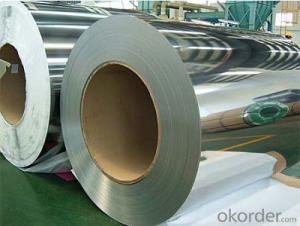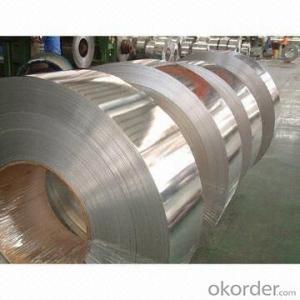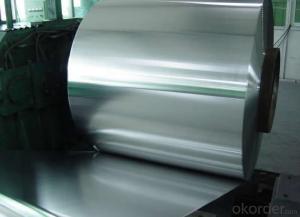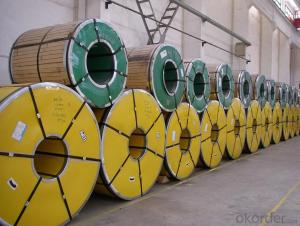Fisrt Class 304 cold rolled stainless steel coil
- Loading Port:
- China main port
- Payment Terms:
- TT OR LC
- Min Order Qty:
- 20 m.t.
- Supply Capability:
- 1000 m.t./month
OKorder Service Pledge
OKorder Financial Service
You Might Also Like
Detail of item:
Article | 304 cold rolling stainless steel coil |
Surface | 2B/BA/HL/No.4/4K/6K/8K |
Technique | Cold rolling |
Length | 0-6000mm |
Width | 1m/1.219m/1.5m |
Thickness | 0.3-3.0mm |
Application | Food industry equipment,Ordinary chemical equipment,building |
Packing | Stainless steel coil will use water-proof paper, steel strip packed, wooden case. Or as your requirements. |
Payment | Small quantity (within total $20000.00): T/T at sight, 30% in advance , 70% after receiving the B/L Large quantity : L/C at sight |
Container Size | 20ft GP:5898mm(Length)x2352mm(Width)x2393mm(High) 40ft GP:12032mm(Length)x2352mm(Width)x2393mm(High) 40ft HC:12032mm(Length)x2352mm(Width)x2698mm(High) |
Delivery Time | 7-15 days after received L/C or the deposit of T/T or WU |
Note | We can produce by other standards or according to your requirement |
Chemical composition :
Grade | C (Max) | Mn (Max) | P (Max) | S (Max) | Si (Max) | Cr | Ni | Mo | Nitrogen (Max) | Cu/ Others |
201 | 0.15 | 5.50-7.50 | 0.06 | 0.03 | 1 | 16.00-18.00 | 3.50-5.50 | - | 0.25 | |
202 | 0.15 | 7.50-10.00 | 0.06 | 0.03 | 1 | 17.00-19.00 | 4.00-6.00 | - | 0.25 | |
301 | 0.15 | 2 | 0.045 | 0.03 | 1 | 16.00 - 18.00 | 6.00 - 8.00 | - | 0.1 | - |
304 | 0.08 | 2 | 0.045 | 0.03 | 1 | 18.00 - 20.00 | 8.00- 10.50 | - | 0.1 | - |
304L | 0.03 | 2 | 0.045 | 0.03 | 1 | 18.00 - 20.00 | 8.00- 12.00 | - | 0.1 | - |
310S | 0.08 | 2 | 0.045 | 0.03 | 1.5 | 24.00- 26.00 | 19.00-22.00 | - | - | - |
316 | 0.08 | 2 | 0.045 | 0.03 | 1 | 16.00 - 18.00 | 10.00- 14.00 | 2.00 - 3.00 | 0.1 | - |
316L | 0.03 | 2 | 0.045 | 0.03 | 1 | 16.00 - 18.00 | 10.00- 14.00 | 2.00 - 3.00 | 0.1 | - |
316Ti | 0.08 | 2 | 0.045 | 0.03 | 1 | 16.00 - 18.00 | 10.00- 14.00 | 2.00 - 3.00 | 0.1 | Ti5x C Min |
317 | 0.08 | 2 | 0.045 | 0.03 | 0.75 | 18.00 - 20.00 | 11.00 - 14.00 | 3.00 - 4.00 | 0.1 | - |
317L | 0.03 | 2 | 0.045 | 0.03 | 0.75 | 18.00 - 20.00 | 11.00 - 15.00 | 3.00 - 4.00 | 0.1 | - |
321 | 0.08 | 2 | 0.045 | 0.03 | 0.75 | 17.00 - 19.00 | 9.00 - 12.00 | - | 0.1 | Ti5xC Min |
347 | 0.08 | 2 | 0.045 | 0.03 | 0.75 | 17.00 - 19.00 | 9.00 - 13.00 | - |
- Q:Are stainless steel strips suitable for low-temperature applications?
- Stainless steel strips are well-suited for use in low-temperature applications. Renowned for its remarkable resistance to corrosion, durability, and high strength, stainless steel proves to be an appropriate material for a variety of applications, including those in low-temperature settings. Stainless steel exhibits a low thermal expansion coefficient, enabling it to endure drastic temperature fluctuations without experiencing significant distortion or harm. It remains stable and maintains its mechanical properties even when subjected to low temperatures. Consequently, stainless steel strips are exceptionally fitting for implementation in cryogenic industries, refrigeration systems, and other low-temperature surroundings. Moreover, stainless steel strips possess admirable resistance to thermal stress and exceptional toughness, ensuring their dependability and performance even under adverse conditions. They possess the ability to withstand low temperatures without becoming brittle or losing their strength. Apart from its mechanical properties, stainless steel also offers excellent corrosion resistance, a crucial quality for low-temperature applications. It can withstand the corrosive impact of chemicals, moisture, and other elements commonly found in low-temperature environments. This resistance serves as a deterrent against rust, corrosion, and degradation, guaranteeing long-term reliability and effectiveness. All in all, stainless steel strips are a suitable alternative for low-temperature applications due to their outstanding mechanical properties, corrosion resistance, and durability. They deliver the necessary strength, stability, and reliability demanded in demanding and extremely cold environments.
- Q:How do stainless steel strips perform in corrosive marine environments?
- Stainless steel strips possess a high resistance to corrosion and exhibit exceptional performance in corrosive marine settings. Their unique composition, consisting of chromium, nickel, and other alloying elements, enables the formation of a protective oxide layer on the surface. This layer acts as a barrier, effectively shielding the strips from corrosive elements like saltwater, moisture, and atmospheric conditions encountered in marine environments. The corrosion-resistant nature of stainless steel strips makes them highly suitable for various marine applications, including boat fittings, marine hardware, offshore platforms, and underwater structures. They are capable of enduring the harsh conditions of saltwater, waves, and high humidity without compromising their structural integrity or aesthetic appeal. Moreover, stainless steel strips offer excellent resistance against pitting and crevice corrosion, which are prevalent forms of corrosion in marine settings. This characteristic ensures their long-term durability and reliability, even in highly corrosive conditions. In addition, stainless steel strips are easy to clean and maintain as they do not require any additional coatings or treatments to protect against corrosion. Regular cleaning with fresh water is typically sufficient to maintain their excellent condition. In conclusion, stainless steel strips are an ideal choice for corrosive marine environments due to their exceptional resistance to corrosion, strength, and durability. They provide a cost-effective and reliable solution that can withstand the challenges posed by the marine environment, ensuring long-lasting performance.
- Q:Can stainless steel strips be used in the production of automotive parts?
- Yes, stainless steel strips can be used in the production of automotive parts. Stainless steel is a durable and corrosion-resistant material, making it suitable for various automotive applications such as exhaust systems, trim parts, brackets, and other components. Its strength, resistance to heat and chemicals, and aesthetic appeal make it a preferred choice in the automotive industry.
- Q:What are the common uses of stainless steel strips in the automotive suspension systems?
- Various purposes necessitate the common usage of stainless steel strips in automotive suspension systems. One of the primary applications lies in the manufacturing of leaf springs, which form an integral part of said suspension system. Leaf springs possess the responsibility of absorbing shocks and preserving the stability of the vehicle. Stainless steel strips offer ideal material qualities for leaf springs, including excellent durability, resistance to corrosion, and high tensile strength. Moreover, the production of coil springs heavily relies on the utilization of stainless steel strips. Coil springs play a crucial role in supporting the vehicle's weight and providing a smooth ride. Stainless steel's exceptional strength-to-weight ratio enables the creation of lightweight coil springs capable of withstanding heavy loads and maintaining their shape over time. Additionally, sway bars or stabilizer bars are fabricated using stainless steel strips. These bars are responsible for minimizing body roll and enhancing the vehicle's handling during cornering. The exceptional strength and resistance to deformation exhibited by stainless steel make it a suitable material for sway bars, thus ensuring optimal performance and longevity. Furthermore, suspension brackets, hangers, and other components that necessitate high strength and resistance to corrosion find application of stainless steel strips. These components are vital for maintaining the structural integrity of the suspension system and ensuring the safe operation of the vehicle. In conclusion, the exceptional mechanical properties, corrosion resistance, and durability of stainless steel strips make them widely employed in automotive suspension systems. They play a vital role in enhancing the performance, stability, and safety of vehicles on the road.
- Q:What are the different types of stainless steel strip alloys?
- Some of the different types of stainless steel strip alloys include austenitic stainless steel, ferritic stainless steel, martensitic stainless steel, and duplex stainless steel.
- Q:What are the different types of welding processes used for stainless steel strips?
- For stainless steel strips, there are various welding processes commonly utilized. These processes encompass: 1. TIG (Tungsten Inert Gas) Welding: Renowned for its capability to create precise and high-quality welds, TIG welding is favored for stainless steel strips. It employs a non-consumable tungsten electrode to generate the arc and an inert gas, like argon, to safeguard the weld pool against impurities. 2. MIG (Metal Inert Gas) Welding: Another prevalent technique for stainless steel strips is MIG welding, which involves a continuous feed of consumable wire electrode through a welding gun. The electrode melts and unites the base metals while an inert gas shield prevents oxidation in the weld area. 3. Plasma Arc Welding: Plasma arc welding is highly versatile and suitable for stainless steel strips. It utilizes a concentrated and high-temperature plasma arc to fuse the metals together. This method provides excellent control and precision, making it well-suited for thin stainless steel strips. 4. Resistance Welding: Resistance welding relies on the heat generated from electrical resistance to join metals. This process can be applied to stainless steel strips using spot or seam welding techniques. It is commonly employed in high-speed production applications. 5. Laser Welding: Laser welding is a contactless process that employs a highly focused laser beam to join stainless steel strips. It offers exceptional precision and control, making it ideal for intricate or delicate welds. Industries that require a superior finish, both aesthetically and in terms of quality, often use laser welding. These represent only a fraction of the welding processes available for stainless steel strips. The selection of a particular process relies on factors such as strip thickness, desired weld quality, production requirements, and the intended application of the stainless steel strips.
- Q:How long do stainless steel strips typically last?
- Stainless steel strips typically have a long lifespan, often lasting several decades with proper care and maintenance.
- Q:What is the price range for stainless steel strips?
- The price range for stainless steel strips can vary depending on various factors such as the thickness, width, and grade of the stainless steel. Generally, stainless steel strips can range in price from around $1 to $10 per square foot. However, for more specialized or high-quality stainless steel strips, the price can go higher. It is important to consider the specific requirements and specifications of the stainless steel strips needed to determine an accurate price range. It is recommended to contact suppliers or manufacturers directly to get a more precise and updated pricing information.
- Q:What are the factors affecting the hardness of 111 stainless steel strips?
- There are several factors that can affect the hardness of 111 stainless steel strips. 1. Alloy composition: The chemical composition of the stainless steel, including the presence of various elements such as chromium, nickel, and manganese, can significantly impact its hardness. Higher levels of these elements generally result in increased hardness. 2. Heat treatment process: The heat treatment process plays a crucial role in determining the hardness of stainless steel. Processes such as annealing, quenching, and tempering can be utilized to manipulate the microstructure of the steel, which directly affects its hardness. 3. Cold working: Cold working, also known as cold rolling or cold drawing, involves deforming the stainless steel at room temperature. This process can significantly increase the hardness of the material by inducing dislocations and strain hardening. 4. Grain size: The grain size of stainless steel is another factor that influences its hardness. Finer grain sizes typically result in higher hardness due to the increased number of grain boundaries, which impede dislocation movement. 5. Presence of impurities: The presence of impurities in stainless steel, such as sulfur and phosphorus, can have a detrimental effect on its hardness. These impurities can promote the formation of non-metallic inclusions, which can reduce the material's hardness. 6. Work hardening: During the manufacturing process of stainless steel strips, work hardening can occur. Work hardening is the increase in hardness that happens as a result of plastic deformation. The level of work hardening depends on factors such as the amount of deformation, strain rate, and the initial hardness of the material. 7. Surface finish: The surface finish of stainless steel strips can also impact their hardness. Factors such as surface roughness and the presence of residual stress can affect the material's hardness by influencing the distribution and behavior of dislocations. It is important to note that the specific combination and interaction of these factors can vary depending on the manufacturing process, alloy type, and intended application of the stainless steel strips. Therefore, a comprehensive understanding of these factors is necessary to effectively control and optimize the hardness of 111 stainless steel strips.
- Q:What are the different types of edges for stainless steel strips?
- Various types of edges can be used in the manufacturing of stainless steel strips, each fulfilling a specific purpose and application. Some commonly used types of edges for stainless steel strips include: 1. Mill Edge: This edge, which is produced during the manufacturing process, is the most common type. It has a slightly rounded or curved shape, making it suitable for general applications. 2. Slit Edge: By slitting the stainless steel strip into narrower widths, this type of edge is achieved. It is typically a straight edge, although it may have slight burrs or roughness. Industries that don't require precision and tight tolerances often use slit edges. 3. Deburred Edge: To eliminate any burrs or roughness on the slit edge, a deburring process is applied. This results in a smooth and rounded edge, ensuring safety and preventing damage during handling. 4. Rolled Edge: Rolling the stainless steel strip produces this type of edge, which is smooth and rounded. Rolled edges are commonly used in applications where safety and aesthetics are important, such as in architectural and decorative uses. 5. Beveled Edge: A beveled edge refers to an angled or sloping cut made on the edge of the stainless steel strip. It is typically used in applications that require welding or joining, as the bevel facilitates better weld penetration and joint strength. 6. Sheared Edge: This type of edge is achieved by cutting the stainless steel strip with a sharp blade. Sheared edges may have slight variations and irregularities but are suitable for applications where precision is not critical. 7. Custom Edges: Depending on specific requirements, stainless steel strips can be manufactured with custom edges. These edges are tailored to meet the unique needs of the application, such as special chamfers, grooves, or profiles. When selecting the appropriate type of edge, it is crucial to consider the intended use and requirements of the stainless steel strip. The choice of edge can impact the functionality, appearance, and compatibility of the strip with different manufacturing processes.
1. Manufacturer Overview |
|
|---|---|
| Location | |
| Year Established | |
| Annual Output Value | |
| Main Markets | |
| Company Certifications | |
2. Manufacturer Certificates |
|
|---|---|
| a) Certification Name | |
| Range | |
| Reference | |
| Validity Period | |
3. Manufacturer Capability |
|
|---|---|
| a)Trade Capacity | |
| Nearest Port | |
| Export Percentage | |
| No.of Employees in Trade Department | |
| Language Spoken: | |
| b)Factory Information | |
| Factory Size: | |
| No. of Production Lines | |
| Contract Manufacturing | |
| Product Price Range | |
Send your message to us
Fisrt Class 304 cold rolled stainless steel coil
- Loading Port:
- China main port
- Payment Terms:
- TT OR LC
- Min Order Qty:
- 20 m.t.
- Supply Capability:
- 1000 m.t./month
OKorder Service Pledge
OKorder Financial Service
Similar products
New products
Hot products
Related keywords































